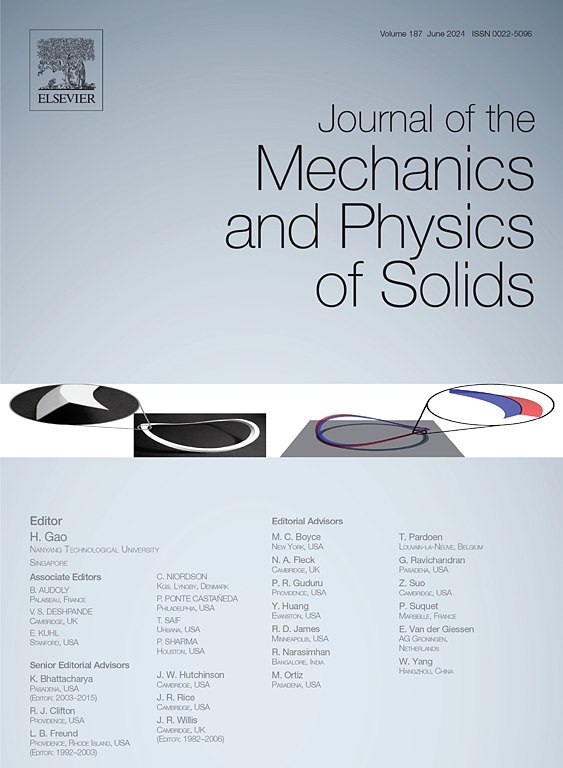Grain-size dependence of plastic-brittle transgranular fracture
IF 5
2区 工程技术
Q2 MATERIALS SCIENCE, MULTIDISCIPLINARY
引用次数: 0
Abstract
The role of grain size in determining fracture toughness in metals is incompletely understood with apparently contradictory experimental observations. We study this grain-size dependence computationally by building a model that combines the phase-field formulation of fracture mechanics with dislocation density-based crystal plasticity. We apply the model to cleavage fracture of body-centered cubic materials in plane strain conditions, and find non-monotonic grain-size dependence of plastic-brittle transgranular fracture. We find two mechanisms at play. The first is the nucleation of failure due to cross-slip in critically located grains within transgranular band of localized deformation, and this follows the classical Hall–Petch law that predicts a higher failure stress for smaller grains. The second is the resistance to the propagation of a mode I crack, where grain boundaries can potentially pin a crack, and this follows an inverse Hall–Petch law with higher toughness for larger grains. The result of the competition between the two mechanisms gives rise to non-monotonic behavior and reconciles the apparently contradictory experimental observations.
塑性-脆性穿晶断裂的粒度依赖性
晶粒尺寸在决定金属断裂韧性中的作用还不完全清楚,实验观察结果明显矛盾。我们通过建立一个将断裂力学相场公式与基于位错密度的晶体塑性相结合的模型,计算研究了这种晶粒尺寸依赖性。将该模型应用于体心立方材料在平面应变条件下的解理断裂,发现了塑性-脆性穿晶断裂的非单调粒度依赖性。我们发现有两种机制在起作用。第一种是局部变形穿晶带内临界位置晶粒的交叉滑移导致的破坏成核,这符合经典的Hall-Petch定律,该定律预测较小晶粒的破坏应力较高。其次是对I型裂纹扩展的阻力,其中晶界可能会固定裂纹,这遵循逆霍尔-佩奇定律,晶粒越大,韧性越高。这两种机制之间竞争的结果产生了非单调行为,并调和了明显矛盾的实验观察。
本文章由计算机程序翻译,如有差异,请以英文原文为准。
求助全文
约1分钟内获得全文
求助全文
来源期刊
CiteScore
9.80
自引率
9.40%
发文量
276
审稿时长
52 days
期刊介绍:
The aim of Journal of The Mechanics and Physics of Solids is to publish research of the highest quality and of lasting significance on the mechanics of solids. The scope is broad, from fundamental concepts in mechanics to the analysis of novel phenomena and applications. Solids are interpreted broadly to include both hard and soft materials as well as natural and synthetic structures. The approach can be theoretical, experimental or computational.This research activity sits within engineering science and the allied areas of applied mathematics, materials science, bio-mechanics, applied physics, and geophysics.
The Journal was founded in 1952 by Rodney Hill, who was its Editor-in-Chief until 1968. The topics of interest to the Journal evolve with developments in the subject but its basic ethos remains the same: to publish research of the highest quality relating to the mechanics of solids. Thus, emphasis is placed on the development of fundamental concepts of mechanics and novel applications of these concepts based on theoretical, experimental or computational approaches, drawing upon the various branches of engineering science and the allied areas within applied mathematics, materials science, structural engineering, applied physics, and geophysics.
The main purpose of the Journal is to foster scientific understanding of the processes of deformation and mechanical failure of all solid materials, both technological and natural, and the connections between these processes and their underlying physical mechanisms. In this sense, the content of the Journal should reflect the current state of the discipline in analysis, experimental observation, and numerical simulation. In the interest of achieving this goal, authors are encouraged to consider the significance of their contributions for the field of mechanics and the implications of their results, in addition to describing the details of their work.

 求助内容:
求助内容: 应助结果提醒方式:
应助结果提醒方式:


